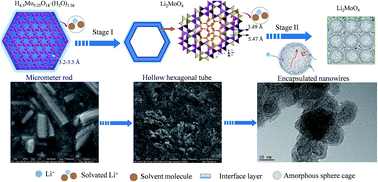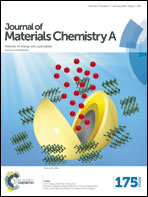Self-activated continuous pulverization film: an insight into the mechanism of the extraordinary long-life cyclability of hexagonal H4.5Mo5.25O18·(H2O)1.36 microrods†
Abstract
For large amounts of transition metal oxides, sulfides and carbon groups (IVA), the pulverization of electrode materials in lithium-ion batteries (LIBs) is always a serious and common problem due to volume expansion and stress accumulation resulting from phase transformation or alloying during the charge–discharge process, which leads to capacity fading and thus limits the cycling performance of LIBs. To solve these problems, conventionally, the rational design of electrode materials is needed. Here in this work, we report the synthesis of a novel anode material, hexagonal H4.5Mo5.25O18·(H2O)1.36 microrods (HMs) via a simple hydrothermal method. During the lithium-ion insertion/desertion process of the HMs, it was found that the HMs are first drastically transformed into Li2MoO4 nanotubes and then Li2MoO4 nanowire clusters embedded in amorphous sphere cages with a Li2O matrix, Mo metal and SEI thin film. Surprisingly, we discovered that the HMs exhibited extraordinary long-life cyclability with an unusual phenomenon: the specific capacity first decreased and then increased. The outstanding electrochemical performance could be explained by the formation of intermediate phase Li2MoO4 nanowires and amorphous sphere cages, which can maintain the lithium-ion paths and electronic transport, and prohibit the mechanical and chemical degradation of the electrode materials. The results show that the pulverization of the HM anode materials induced by lithium-ion insertion–extraction played a trigger role in the formation of a continuous pulverization film. Accordingly, a “damage-reconstruction” model based on ex situ XRD and FESEM analyses combined with ex situ XPS, FTIR and TEM characterizations of the charge–discharge process was proposed to explain such an unusual and intriguing finding. Compared with the conventional method for protecting electrode materials from pulverization, the robust continuous gel-like pulverization film containing a unique combination of intermediate phase and amorphous sphere cages provides a new insight into the mechanism for the extraordinary long-term cyclability of electrode materials.


 Please wait while we load your content...
Please wait while we load your content...